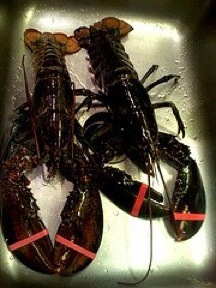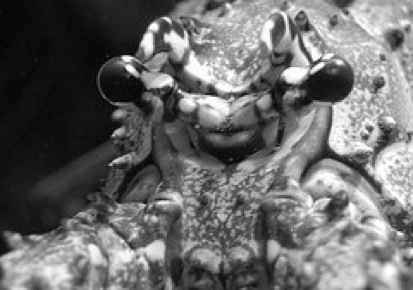Better Than Crabs!

Domain: Eukarya
Kingdom: Animalia
Phylum: Arthropoda
Superclass: Crustacea
Class: Malacostraca
Order: Decapoda
Family: Nephropidae
Genus: Homarus
Species: H. americanus
Domain:
The American lobster is classified as a member of the Domain Eukarya because of
the presence of a true nucleus as well as specialized, membrane-bound organelles.
Kingdom:
Members of the Kingdom Animalia are multicellular as well as heterotrophic (they
rely on other organisms for direct supply of nutrition via ingestion).
Phylum:
The Phylum Arthropoda is the
most abundant and diverse
eukaryotic phylum and includes
organisms that are bilaterally
symmetrical invertebrates that
have complex jointed exoskeletons
that allow for movement. These
organisms also have segmented
bodies and their bodies are
separated into distinct head and
trunk regions (but the trunk can be
separated further into a thorax
and abdomen). Typically, these
organisms develop eyes and molt
often to allow for body size
expansion.
Superclass:
Crustaceans are organisms that live primarily in aquatic environments and are
protected by the presence of a chitinous exoskeleton (which also gives support for
the attachment of muscles). Their segmentation is even more distinct with
cephalothroax and abdomen regions. Additional characteristics include two pairs of
antennae (which aid in sensory perception) and complex eyes on stalks.
Class:
Members of the Class Malacostraca include
the larger species of Crustaceans. The
segmentation of these organisms is as follows:
the head consists of five segments, eight
segments compose the thorax, and six or
seven segments make up the abdomen.
However, not all species have a cephalothorax.
Generalizations about this Class are difficult to
maintain because the species are so varied.
Order:
The Order Decapoda contains organisms with ten legs, which are the last five pairs
of thoracic appendages, they’ve just been modified into legs used for locomotion;
however, the front pair of walking legs may have enlarged pinchers, which are
called chelipeds. The first three pairs, which function as mouth parts, are referred to
as the maxillipeds.
Family:
The Family Nephropidae is
also referred to as the family
of clawed lobsters, and these
claws are usually highly
specialized and unequal in
size due to favoritism; the
larger of the two claws
becomes the crusher claw,
while the smaller claw is the
pincher.
Genus:
The members of the Genus Homarus include the American lobster (H. americanus)
and the European lobster (H. gammarus), two of the most commercially popular
lobster species. These two species are extremely difficult to differentiate and can
only be done so by examining habitat (western vs. eastern Atlantic) as well as the
presence of teeth on the underside of the rostrum, which is an extension of the
carapace.
Species:
The Species H. americanus is found in the northwestern portion of the Atlantic
Ocean. This organism not only provides meat from its tail, but also from it’s claws.
So please continue this journey and learn more about this incredible creature!
Go back to the home page!




